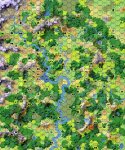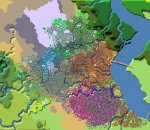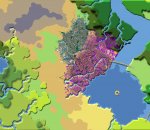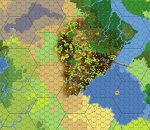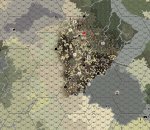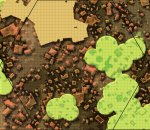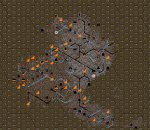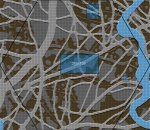The1True
8, 8, I forget what is for
Before I dropped everything to go all-in on the doomed Vanished Wastes project, I had been grinding away for a couple of years at a "megadungeon". I'd hate to declare this earlier project moribund but it's definitely slowed down. However, a lot of great content resulted and since the likelihood of it ever becoming a Kickstarter darling is increasingly non-existent, I thought I'd write up a series of posts sharing my work. Maybe people can find some useful material/inspiration/schadenfreude. As I mentioned over in my Post Mortem thread, adventure writing is a lonely pursuit and I'd love to hear suggestions, share war stories, bask in warm praise/cower under cruel contempt.
A few years ago, a series of great ideas hit me all at once. The first was The Angry GM's series on writing a megadungeon. At the time, it was pretty cool how he systematically laid out his work structure and the framework of his dungeon. The series later lost its way and I stopped checking in, but at its outset, it really seemed like, unlike so many other bloggers who'd crashed and foundered on the megadungeon rocks, this was a real formula for powering through the many pitfalls of writing a large adventure. (Turns out, it was not...which actually...worth its own thread altogether: What the hell combination of obsessive determination, time and project management do the rare few megadungeon 'finishers' like Greg Gillespie, @Melan, Michael Curtis etc. have that gets them past that mid-megadungeon stall?)
At the same time I was reading "The City" by Stella Gemmel, widow and writing partner of David Gemmel (check out "Lord of the Silver Bow" for another example of their fantastic work). "The City" was one of those okay novels that you plough through anyway because it's full of evocative ideas. In my case, what really struck me was the notion of a small state-sized city (a little like Constantinople) with an enormous underground realm full of the slowly degrading machinery of a society in decline and layer upon layer of previous iterations of the city intersecting with sewers, basements and catacombs of the world above.
This sent me down the internet rabbit hole on societal collapse. In particular, I was interested in the recovery of 'western' civilization after the Black Plague and the influence of ruination, massive depopulation and the ever-present specter of death and disease had on people, culture and architecture. I got way into medieval gothic, remembering in particular the fantastic art of early Games Workshop material, particularly the artwork of Ian Miller. I never plaid Mordheim but I'm sure I absorbed some of that from old White Dwarfs...

Finally, it was at this point that I started my first deep dives into the OSR where I encountered Chris Kutalik's fantastic Ruins Crawl concept, The Alexandrian's in-depth series of essays on Urban Crawls and Jed McClure's Wilderness Hexplore which has defined hex-stocking for me and I ended up riffing on/ripping off extensively.
I dove into my project obsessively. To have a titanic dungeon, I'd need a ruined city. To have a ruined city, I'd need a ruined kingdom. To have all this ruination, I'd need some backstory. In the next couple of posts I'll describe first the kingdom and backstory, then the city itself and finally drill right down into the underworld below!
A few years ago, a series of great ideas hit me all at once. The first was The Angry GM's series on writing a megadungeon. At the time, it was pretty cool how he systematically laid out his work structure and the framework of his dungeon. The series later lost its way and I stopped checking in, but at its outset, it really seemed like, unlike so many other bloggers who'd crashed and foundered on the megadungeon rocks, this was a real formula for powering through the many pitfalls of writing a large adventure. (Turns out, it was not...which actually...worth its own thread altogether: What the hell combination of obsessive determination, time and project management do the rare few megadungeon 'finishers' like Greg Gillespie, @Melan, Michael Curtis etc. have that gets them past that mid-megadungeon stall?)
At the same time I was reading "The City" by Stella Gemmel, widow and writing partner of David Gemmel (check out "Lord of the Silver Bow" for another example of their fantastic work). "The City" was one of those okay novels that you plough through anyway because it's full of evocative ideas. In my case, what really struck me was the notion of a small state-sized city (a little like Constantinople) with an enormous underground realm full of the slowly degrading machinery of a society in decline and layer upon layer of previous iterations of the city intersecting with sewers, basements and catacombs of the world above.
This sent me down the internet rabbit hole on societal collapse. In particular, I was interested in the recovery of 'western' civilization after the Black Plague and the influence of ruination, massive depopulation and the ever-present specter of death and disease had on people, culture and architecture. I got way into medieval gothic, remembering in particular the fantastic art of early Games Workshop material, particularly the artwork of Ian Miller. I never plaid Mordheim but I'm sure I absorbed some of that from old White Dwarfs...

Finally, it was at this point that I started my first deep dives into the OSR where I encountered Chris Kutalik's fantastic Ruins Crawl concept, The Alexandrian's in-depth series of essays on Urban Crawls and Jed McClure's Wilderness Hexplore which has defined hex-stocking for me and I ended up riffing on/ripping off extensively.
I dove into my project obsessively. To have a titanic dungeon, I'd need a ruined city. To have a ruined city, I'd need a ruined kingdom. To have all this ruination, I'd need some backstory. In the next couple of posts I'll describe first the kingdom and backstory, then the city itself and finally drill right down into the underworld below!
